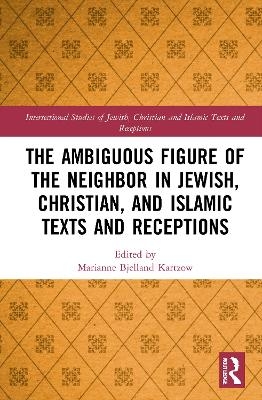
The Ambiguous Figure of the Neighbor in Jewish, Christian, and Islamic Texts and Receptions
Routledge (Verlag)
978-0-367-63784-2 (ISBN)
Through a variety of case studies using diverse methods and material, chapters explore the neighbor in these neighboring texts and traditions. The figure of the neighbor seems like an innocent topic at the surface. It is an everyday phenomenon, that everyone have knowledge about and experiences with. Still, analytically, it has a rich and innovative potential. Recent interdisciplinary research employs this figure to address issues of cultural diversity, gender, migration, ethnic relationships, war and peace, environmental challenges and urbanization. The neighbor represents the borderline between insider and outsider, friend and enemy, us and them. This ambiguous status makes the neighbor particularly interesting as an entry point into issues of cultural complexity, self-definition and identity. This volume brings all the intersections of religion, ethnicity, gender, and socio-cultural diversity into the same neighborhood, paying attention to sacred texts, receptions and contemporary communities.
The Ambiguous Figure of the Neighbor in Jewish, Christian, and Islamic Texts and Receptions offers a fascinating study of the intersections between Jewish, Christian and Islamic text, and will be of interest to anyone working on these traditions.
Marianne Bjelland Kartzow is Professor of New Testament Studies at the Faculty of Theology at the University of Oslo, Norway.
Introduction: The Ambiguous Figure of the Neighbor in Jewish, Christian, and Islamic Texts and Receptions-Marianne Bjelland Kartzow; Part 1: Intersectional Biblical Neighbors; 1 The Ambiguous Neighbor in the Hebrew Bible: A Survey of the Language of Neighbourship and the Narrative Function of the Neighbour in Hebrew Bible Texts-Anne Katrine de Hemmer Gudme; 2 When Bethlehemites and Moabites Meet: Ambiguous Neighbors in the Book of Ruth, Kristin Joachimsen; 3 Neighbour, Townsperson, and Fellow Creature: The Regulation of Inter-Human Relationships in Palestinian Rabbinic Texts-Catherine Hezser; 4 Monsters and Angels: The Function and Evaluation of the Intersectional Neighbors in the Gospels-Marianne Bjelland Kartzow; Part 2: Islamic Neighbors, Near and Far; 5 Aw qala: ‘Li-jarihi‘. Some Observations on Brotherhood and Neighborly Love in Islamic Tradition-Oddbjørn Leirvik; 6 The Ambiguous jār: Towards a Qurʾanic Neighborhood Ethics-Nora S. Eggen; Part 3 Negotiating the ambiguous neighborhood in peace and war, conflict and coexistence; 7 Neighbour in the war: Saviour or murderer? Rethinking neighbourhood in Bosnia-Safet Bektovic; 8 The childless woman and her neighbours: Exploring neighbourliness within a rural community in Cameroon-Gladys Ekone Wang; 9 Imagining the Everyday Life of Jewish and Christian "Neighbors" in Late Antique Capernaum: Beyond Church and Synagogue—and Back Again-Wally V. Cirafesi; 10 Narratives of the suburb as religious neighbourhood: How a local church and mosque in an Oslo suburb negotiate Muslim-Christian neighbourly relations-Anne Hege Grung
| Erscheinungsdatum | 12.09.2024 |
|---|---|
| Reihe/Serie | Intersectional Studies of Jewish, Christian and Islamic Texts and Receptions |
| Zusatzinfo | 2 Halftones, black and white; 2 Illustrations, black and white |
| Verlagsort | London |
| Sprache | englisch |
| Maße | 156 x 234 mm |
| Gewicht | 444 g |
| Themenwelt | Geschichte ► Allgemeine Geschichte ► Vor- und Frühgeschichte |
| Religion / Theologie ► Christentum ► Kirchengeschichte | |
| Geisteswissenschaften ► Religion / Theologie ► Judentum | |
| ISBN-10 | 0-367-63784-7 / 0367637847 |
| ISBN-13 | 978-0-367-63784-2 / 9780367637842 |
| Zustand | Neuware |
| Informationen gemäß Produktsicherheitsverordnung (GPSR) | |
| Haben Sie eine Frage zum Produkt? |
aus dem Bereich


